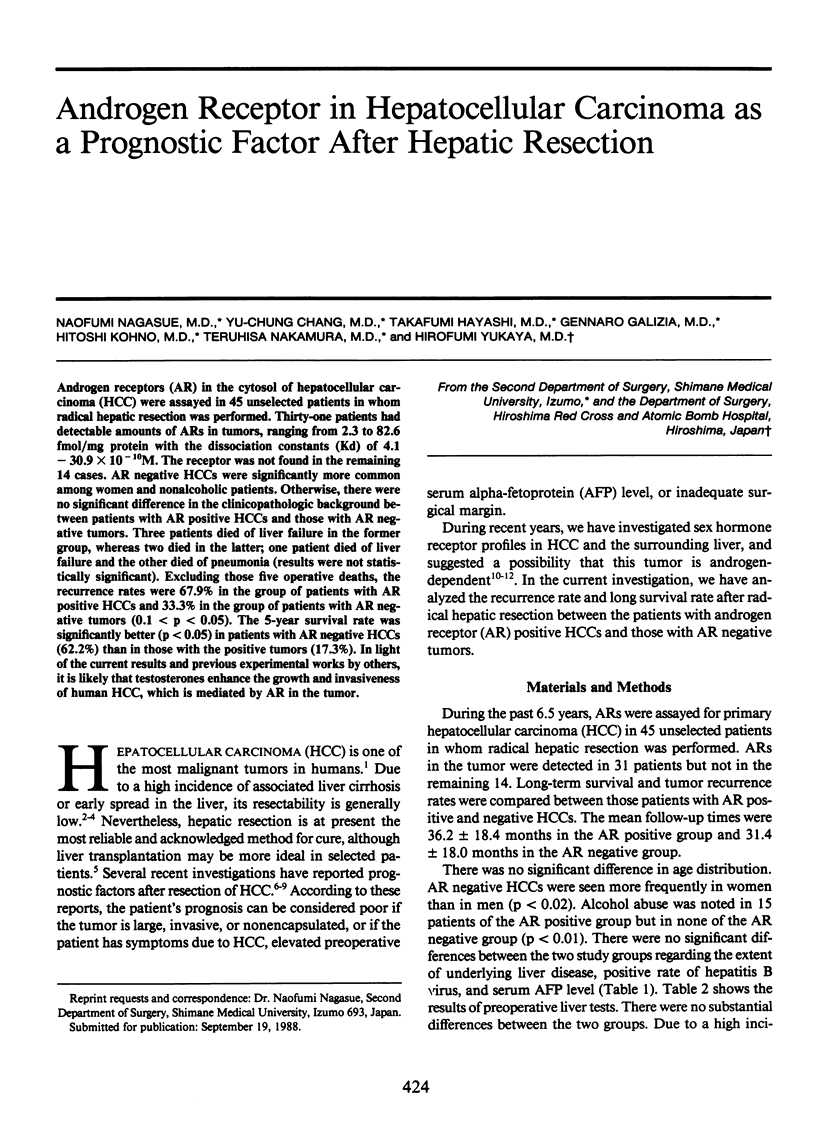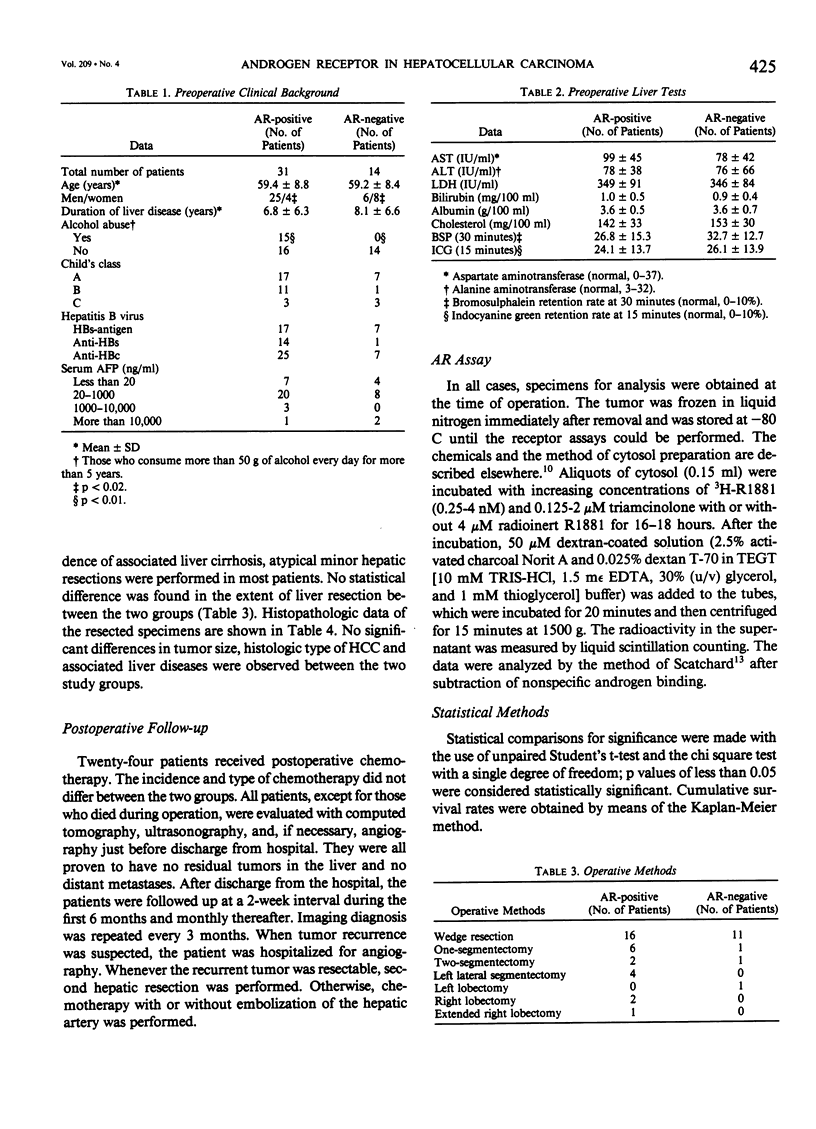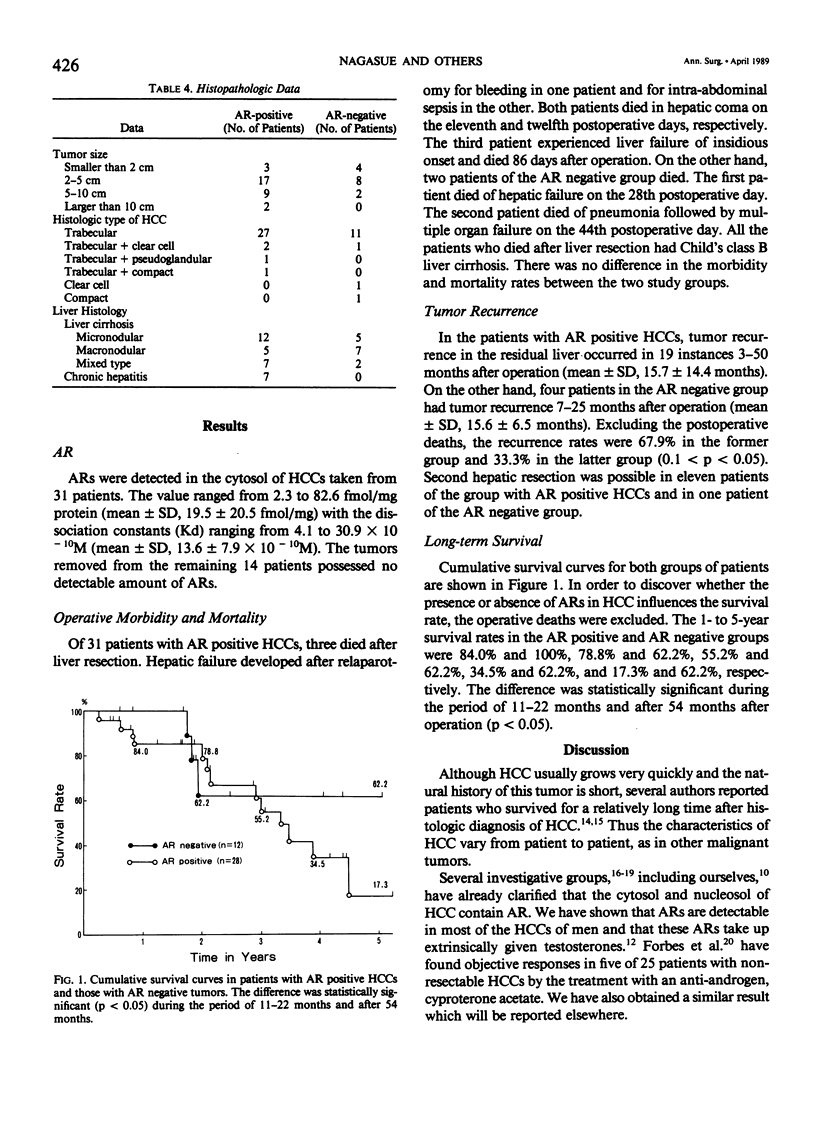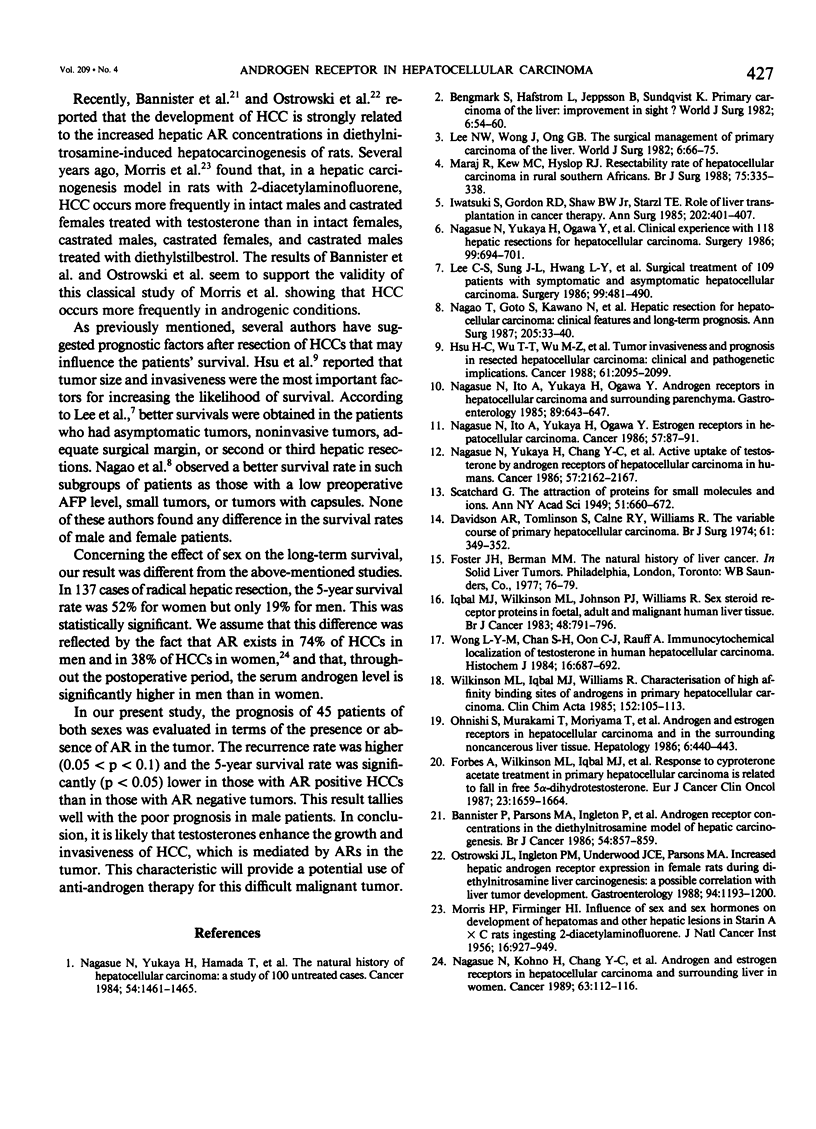Abstract
Androgen receptors (AR) in the cytosol of hepatocellular carcinoma (HCC) were assayed in 45 unselected patients in whom radical hepatic resection was performed. Thirty-one patients had detectable amounts of ARs in tumors, ranging from 2.3 to 82.6 fmol/mg protein with the dissociation constants (Kd) of 4.1 - 30.9 x 10(-10) M. The receptor was not found in the remaining 14 cases. AR negative HCCs were significantly more common among women and nonalcoholic patients. Otherwise, there were no significant difference in the clinicopathologic background between patients with AR positive HCCs and those with AR negative tumors. Three patients died of liver failure in the former group, whereas two died in the latter; one patient died of liver failure and the other died of pneumonia (results were not statistically significant). Excluding those five operative deaths, the recurrence rates were 67.9% in the group of patients with AR positive HCCs and 33.3% in the group of patients with AR negative tumors (0.1 less than p less than 0.05). The 5-year survival rate was significantly better (p less than 0.05) in patients with AR negative HCCs (62.2%) than in those with the positive tumors (17.3%). In light of the current results and previous experimental works by others, it is likely that testosterones enhance the growth and invasiveness of human HCC, which is mediated by AR in the tumor.
Full text
PDF



Selected References
These references are in PubMed. This may not be the complete list of references from this article.
- Bannister P., Parsons M. A., Ingleton P., Underwood J. C., Losowsky M. S. Androgen receptor concentrations in the diethylnitrosamine model of hepatic carcinogenesis. Br J Cancer. 1986 Nov;54(5):857–859. doi: 10.1038/bjc.1986.252. [DOI] [PMC free article] [PubMed] [Google Scholar]
- Bengmark S., Hafström L., Jeppsson B., Sundqvist K. Primary carcinoma of the liver: improvement in sight? World J Surg. 1982 Jan;6(1):54–60. doi: 10.1007/BF01656373. [DOI] [PubMed] [Google Scholar]
- Davidson A. R., Tomlinson S., Calne R. Y., Williams R. The variable course of primary hepatocellular carcinoma. Br J Surg. 1974 May;61(5):349–352. doi: 10.1002/bjs.1800610504. [DOI] [PubMed] [Google Scholar]
- Forbes A., Wilkinson M. L., Iqbal M. J., Johnson P. J., Williams R. Response to cyproterone acetate treatment in primary hepatocellular carcinoma is related to fall in free 5 alpha-dihydrotestosterone. Eur J Cancer Clin Oncol. 1987 Nov;23(11):1659–1664. doi: 10.1016/0277-5379(87)90446-9. [DOI] [PubMed] [Google Scholar]
- Hsu H. C., Wu T. T., Wu M. Z., Sheu J. C., Lee C. S., Chen D. S. Tumor invasiveness and prognosis in resected hepatocellular carcinoma. Clinical and pathogenetic implications. Cancer. 1988 May 15;61(10):2095–2099. doi: 10.1002/1097-0142(19880515)61:10<2095::aid-cncr2820611027>3.0.co;2-h. [DOI] [PubMed] [Google Scholar]
- Iqbal M. J., Wilkinson M. L., Johnson P. J., Williams R. Sex steroid receptor proteins in foetal, adult and malignant human liver tissue. Br J Cancer. 1983 Dec;48(6):791–796. doi: 10.1038/bjc.1983.268. [DOI] [PMC free article] [PubMed] [Google Scholar]
- Iwatsuki S., Gordon R. D., Shaw B. W., Jr, Starzl T. E. Role of liver transplantation in cancer therapy. Ann Surg. 1985 Oct;202(4):401–407. doi: 10.1097/00000658-198510000-00001. [DOI] [PMC free article] [PubMed] [Google Scholar]
- Lee C. S., Sung J. L., Hwang L. Y., Sheu J. C., Chen D. S., Lin T. Y., Beasley R. P. Surgical treatment of 109 patients with symptomatic and asymptomatic hepatocellular carcinoma. Surgery. 1986 Apr;99(4):481–490. [PubMed] [Google Scholar]
- Lee N. W., Wong J., Ong G. B. The surgical management of primary carcinoma of the liver. World J Surg. 1982 Jan;6(1):66–75. doi: 10.1007/BF01656375. [DOI] [PubMed] [Google Scholar]
- MORRIS H. P., FIRMINGER H. I. Influence of sex and sex hormones on development of hepatomas and other hepatic lesions in strain AX C rats ingesting 2-diacetylaminofluorene. J Natl Cancer Inst. 1956 Feb;16(4):927–949. [PubMed] [Google Scholar]
- Maraj R., Kew M. C., Hyslop R. J. Resectability rate of hepatocellular carcinoma in rural southern Africans. Br J Surg. 1988 Apr;75(4):335–338. doi: 10.1002/bjs.1800750413. [DOI] [PubMed] [Google Scholar]
- Nagao T., Inoue S., Goto S., Mizuta T., Omori Y., Kawano N., Morioka Y. Hepatic resection for hepatocellular carcinoma. Clinical features and long-term prognosis. Ann Surg. 1987 Jan;205(1):33–40. doi: 10.1097/00000658-198701000-00006. [DOI] [PMC free article] [PubMed] [Google Scholar]
- Nagasue N., Ito A., Yukaya H., Ogawa Y. Androgen receptors in hepatocellular carcinoma and surrounding parenchyma. Gastroenterology. 1985 Sep;89(3):643–647. doi: 10.1016/0016-5085(85)90463-9. [DOI] [PubMed] [Google Scholar]
- Nagasue N., Ito A., Yukaya H., Ogawa Y. Estrogen receptors in hepatocellular carcinoma. Cancer. 1986 Jan 1;57(1):87–91. doi: 10.1002/1097-0142(19860101)57:1<87::aid-cncr2820570118>3.0.co;2-k. [DOI] [PubMed] [Google Scholar]
- Nagasue N., Kohno H., Chang Y. C., Hayashi T., Utsumi Y., Nakamura T., Yukaya H. Androgen and estrogen receptors in hepatocellular carcinoma and the surrounding liver in women. Cancer. 1989 Jan 1;63(1):112–116. doi: 10.1002/1097-0142(19890101)63:1<112::aid-cncr2820630118>3.0.co;2-p. [DOI] [PubMed] [Google Scholar]
- Nagasue N., Yukaya H., Chang Y. C., Ogawa Y., Kohno H., Ito A. Active uptake of testosterone by androgen receptors of hepatocellular carcinoma in humans. Cancer. 1986 Jun 1;57(11):2162–2167. doi: 10.1002/1097-0142(19860601)57:11<2162::aid-cncr2820571114>3.0.co;2-6. [DOI] [PubMed] [Google Scholar]
- Nagasue N., Yukaya H., Hamada T., Hirose S., Kanashima R., Inokuchi K. The natural history of hepatocellular carcinoma. A study of 100 untreated cases. Cancer. 1984 Oct 1;54(7):1461–1465. doi: 10.1002/1097-0142(19841001)54:7<1461::aid-cncr2820540740>3.0.co;2-7. [DOI] [PubMed] [Google Scholar]
- Nagasue N., Yukaya H., Ogawa Y., Sasaki Y., Chang Y. C., Niimi K. Clinical experience with 118 hepatic resections for hepatocellular carcinoma. Surgery. 1986 Jun;99(6):694–701. [PubMed] [Google Scholar]
- Ohnishi S., Murakami T., Moriyama T., Mitamura K., Imawari M. Androgen and estrogen receptors in hepatocellular carcinoma and in the surrounding noncancerous liver tissue. Hepatology. 1986 May-Jun;6(3):440–443. doi: 10.1002/hep.1840060320. [DOI] [PubMed] [Google Scholar]
- Ostrowski J. L., Ingleton P. M., Underwood J. C., Parsons M. A. Increased hepatic androgen receptor expression in female rats during diethylnitrosamine liver carcinogenesis. A possible correlation with liver tumor development. Gastroenterology. 1988 May;94(5 Pt 1):1193–1200. doi: 10.1016/0016-5085(88)90012-1. [DOI] [PubMed] [Google Scholar]
- Wilkinson M. L., Iqbal M. J., Williams R. Characterisation of high affinity binding sites of androgens in primary hepatocellular carcinoma. Clin Chim Acta. 1985 Oct 31;152(1-2):105–113. doi: 10.1016/0009-8981(85)90181-0. [DOI] [PubMed] [Google Scholar]
- Wong L. Y., Chan S. H., Oon C. J., Rauff A. Immunocytochemical localization of testosterone in human hepatocellular carcinoma. Histochem J. 1984 Jun;16(6):687–692. doi: 10.1007/BF01003395. [DOI] [PubMed] [Google Scholar]


